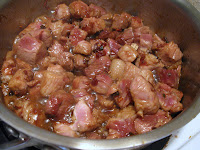This is my version of a recipe that's been making the rounds of the cooking blogs since it appeared in the New York Times in March. the NY Times has an occasional column--Recipe Redux--where some chef-of-the-moment remakes a recipe that appeared in the paper a few decades previously. This time David Lebovitz redid Maida Heatter's 1966 popover recipe by adding a little sugar to the dough and a whole lot of sugar to the outside. In the accompanying article, he's quoted as saying: “It’s like a cinnamon doughnut. Who needs the fried and all the inside? You want the crunch.” Crunchy donuts? The article's author, Amanda Hesser describes them as "part soufflé, part doughnut, part cinnamon toast." which is more on the mark to my mind.
I changed the recipe a little by using for the generic "1 cup flour", half a cup of bread flour and half a cup of whole wheat pastry flour. I had some success when I used this combination for crêpes a while back so I figured it was worth trying here too. I also used some vanilla sugar in the coating along with the cinnamon.
Ingredients:
For the puffs:
Softened unsalted butter, for greasing the pan
2 tablespoons butter, melted
3 large eggs, at room temperature
1 cup whole milk
1 teaspoon salt
1 1/2 teaspoons sugar
1 cup flour
For the sugar coating:
2/3 cup sugar
1 teaspoon ground cinnamon
4 tablespoons butter, melted.
1. Preheat the oven to 400 degrees. Liberally grease a nonstick popover pan, or a muffin pan with 1/2-cup indentations, with softened butter.
2. For the puffs, put the 2 tablespoons melted butter, eggs, milk, salt and sugar in a blender and whiz for a few seconds.
3. Add the flour and whiz for 5 to 8 seconds, just until smooth.

[I've never made popovers before so I didn't know that the dough was going to be so very thin. I double-checked that I had done everything correctly, but I was still skeptical that I had done it right.]
4. Divide the batter among 9 greased molds, filling each 1/2 to 2/3 full.
[My skepticism increased when I found I could fill all 12 molds 2/3 full.]
5. Bake for 35 minutes, until the puffs are deep brown.
[The word "deep" there makes a big difference, and judging from the pictures and descriptions on many of the blogs, a lot of people are missing it. I did too.]
6. Remove from the oven, wait a few minutes until cool enough to handle, then remove the puffs from the pans. You may need a small knife to help pry them out.
7. Mix the sugar and cinnamon in a medium bowl. Thoroughly brush each puff all over with

melted butter, then dredge in sugar and cinnamon mixture to coat completely. Let cool on a baking rack. Makes 9 puffs.
[I found brushing the puffs while they sat in a wide-mouthed bowl kept the mess to a minimum. Plus, by the end of the process, the dripped butter was coating the bottoms while I was brushing the tops. There wasn't quite enough sugar for a proper dredge so it was more of a roll and pour over-top process. I ended up with about a third of the sugar and butter left over even having to coat a full dozen puffs so you can cut back on the amounts here without a problem.]
I got halfway through the brushing and dredging procedure before I decided to actually try one

of the puffs. I found it to be rather undercooked--soggy and eggy in the middle. I had done the full 35 minutes so I took another look at the recipe to see if I missed something. I had: the word "deep". I had taken out the puffs when they were golden brown as your impulse would have been to do to. Look at them; Those look done.
If they were just a little more done, I could have passed them off as soufflé-like in the middle, but as it was they had to be fixed. So I reheated the oven to 400 degrees, put the puffs back in

the muffin pan and then back in the oven to continue baking. I checked every five minutes and at 15, they looked ready. Sorry, I neglected to take a picture before I returned to coating them, but here's one after:
You can kind of see the deeper brown.

The texture is crisp on the outside and inside, light and airy with a thin layer of chewy in between. I like the way the sugar melted a bit into a glaze on the pre-coated ones, but not enough to recommend doing what I did deliberately. The flavor is the rich eggy sweet/savory mix of cinnamon french toast. Not bad at all, if you like your deserts and/or breakfast pastry on the reserved side (as far as sweetness goes. Nothing reserved about the levels of fat in here). And certainly easy enough, too.
I'm curious about savory popovers now. Maybe I ought to make beef Wellington.


















































